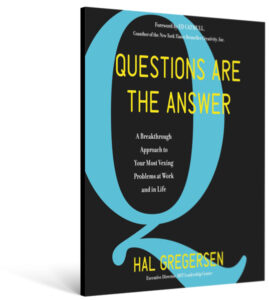The Interrobang Effect: How Asking Better Questions Changes Everything with Humans and Machines
A range of techniques are available to enhance the range of questions asked of man and machines, optimising output, and enhancing productivity.
A range of techniques are available to enhance the range of questions asked of man and machines, optimising output, and enhancing productivity.

By Derek Ariss
In an era characterised by relentless and rapid change, we face an array of formidable challenges. These dynamic times prompt us to ponder: how can we successfully navigate change, uncover superior solutions, and optimise the tools at our disposal? The answer lies in the art of asking the right question.
These days the power of questioning is becoming a transformative leadership tool. This article examines a range of questioning techniques, focusing on their ability to shape our thought processes, ignite creativity, and guide us toward ground-breaking solutions. What makes this journey exciting is the tangible and quick results it delivers. Exploring the significance of asking refined questions reveals their potential to drive change, enhance decision-making, guide thinking, empower problem-solving, and even leverage the capabilities of AI.
In essence, we aspire to pose questions that elicit answers accompanied by an exclamation reminiscent of an interrobang, a question that elicits an answer accompanied by an exclamation – an outcome that is both impactful and transformative.
This article will highlight the benefits of asking better questions by looking at how they can:
The mastery of posing insightful questions lies at the core of instigating change and augmenting performance. Whether one is an individual striving for personal advancement, a team aiming for excellence, or an entire organisation pursuing transformation, questions serve as the guiding beacon.
One technique of asking questions resulting in improved performance is called the ‘5 Whys’ technique.
In the mid-20th century, Toyota encountered substantial challenges related to quality and production efficiency. Taiichi Ohno, inspired by the principles of statistical process control and adept problem-solving methods, embarked on developing a system to address these concerns. Ohno and his team refined a problem-solving technique centred on repeatedly asking “’why?”’ to uncover the root causes of issues. This evolved into the renowned ‘5 Whys’ technique, which has become an integral aspect of Toyota’s problem-solving culture. The impact of this root-cause analysis technique extends far beyond Lean manufacturing, permeating industries such as software development, healthcare, project management, and finance. It has become a foundational tool with broad applicability.
So, how can we leverage this powerful technique? As an example, the ‘5 Whys’ approach encourages a deep dive into issues by repeatedly asking “why?” This method unveils the fundamental causes of a problem, shifting the focus from addressing symptoms to penetrating the core of the matter. In a way reminiscent of a child persistently asking “why?” until the heart of the matter is revealed. Fostering a culture of root-cause inquiry within an organisation empowers employees to explore innovative solutions. This not only improves efficiency but also contributes to overall organisational success.
Try it as an exercise. The next time you have a small issue and someone explains the rationale ‘why’ (politely) several times over, you will be amazed that the actual cause of the issue is seldom clear in the first explanation. Often, people will only get to the real cause of an issue after a series of more profound questions. For example, when a product launch had total impact of 60% lower than projected, we thought that perhaps the messaging didn’t meet the audience need or the targeted media was off the mark. After reviewing the 5 Why’s, it was discovered that it had nothing to do with our messaging. There was a distribution problem. The messaging didn’t go out on time because of a programme delivery issue. By spending time identifying the root cause, time was saved on solving a major issue.
Good questions can do much more than deliver change and performance improvements; they also enhance decision-making.
Effective decision-making hinges on achieving clarity and considering multiple perspectives. Skilful questioning can illuminate blind spots, challenge assumptions, and facilitate a comprehensive analysis of situations. When faced with dilemmas, questions such as “what are the potential risks and benefits?” or “how does this decision align with our long-term goals?” prove invaluable. These precise queries promote critical thinking and establish a structured framework for evaluating options, resulting in well-informed and confident choices.

Five questions are a starting checklist for critical thinking:
Incorporating these critical thinking questions into your decision-making process is a valuable starting place. By consistently challenging assumptions, considering alternative perspectives, and evaluating evidence, you not only navigate through dilemmas effectively but also cultivate a powerful skill that enhances your overall decision-making capabilities.
While this form of questioning can lead to a clear decision, another form can guide thinking.
Guide Thinking Through Socratic Questioning
Based on the teachings of the ancient philosopher Socrates, the Socratic method follows a logical sequence of prompts that directs individuals or groups to analyse their beliefs, assumptions, and implications critically. By employing this technique, one can steer conversations and help people discover deep insights. This approach is powerful in fostering an understanding and refining of decision-making processes. When participants discover answers to solve work and personal issues, they ‘own’ the process.
This method is advantageous when trying to gather information on topics with multiple perspectives or when engaging in discussions where opinions may differ.
To use the Socratic method effectively, follow these steps:
The following are some examples of Socratic questions that can help uncover hidden gems:
What alternative viewpoints should be considered?
Using the Socratic method truly guides thinking and allows individuals or groups to come to a conclusion. The strength here is that they are guided toward the solution, yet they are the ones that draw a conclusion based on their personal thoughts. This increases buy in, learning, and ownership.
Often when solving a problem, leaders need to see multiple perspectives and opportunities. How can this be accomplished? It can’t always be done through critiquing or directing. Instead of directing answers in one direction, multiple answers may be required.
Embracing inquiries like “What if?” and “How might we?” ignite creativity and exploration. Imagine addressing a challenge by asking, “What if we approached this from a completely different angle?” or “How might we reshape this process to achieve unexpected outcomes?” Such questions stimulate thinking beyond the ordinary, sparking innovative solutions and pushing the boundaries of traditional problem-solving. Through open-ended questions, individuals enhance their capacity to overcome obstacles with ingenuity and originality. Consider, for instance, questions like “If we no longer used plastic straws would that reduce the environmental impact of plastics?”, or “How might we discourage the use of plastic shopping bags to mitigate plastic’s environmental impact?”.

We can take this questioning technique one step further to find better answers. One technique has been developed by Hal Gregersen, a senior lecturer in leadership and innovation at MIT’s Sloan School of Management, and a former executive director of the MIT Leadership Center. He wrote a book entitled “Questions Are the Answer: A Breakthrough Approach to Your Most Vexing Problems at Work and In Life.” In the book he describes a technique called “Question Storming”. Instead of looking at solving a problem by asking a single question the technique involves generating a large number of questions in a short amount of time, for example as little as four minutes.
The idea behind question storming is to create a fertile ground of exploration and innovation by encouraging individuals and teams to ask various questions that break away from conventional thinking, challenge assumptions, and uncover new possibilities. The result of the exercise is that it creates a rich reservoir of questions that can be analysed and prioritised to identify the most relevant and impactful ones for further exploration.
Using this technique steers people away from their standard solutions and forces them to look at the issue from perspectives that might never have originally been considered.
How can these essential questioning techniques work in a data-driven world where generative AI is seeping into everything we do? Well, the link is more direct than might have initially been thought.
In today’s organisational dynamics, the power of questions finds new dimensions when coupled with technology. In an organisation where questioning is encouraged and developed to see continuous improvement, imagine the power that could be unleashed when asking solid questions to the AI interfaces that presently exist. AI-powered tools provide answers based on the questions they receive. Valuable outputs occur when we can leverage our ability to ask questions with the strengths of compiling information with AI tools.
Behind the scenes of AI-powered question answering lies the concept of Prompt Engineering. Large language models such as GPT4 excel at understanding and generating human-like text based on prompts they receive. When we can craft these prompts carefully to instruct and guide AI’s responses, we can then harness the full potential of AI to shape insightful output. The better the questions asked, the better and more impactful the answers become. For example, if you ask a Large Language Model about the mega-investment trends concerning next-generation clients, you will get a good solution. However, suppose you ask the Large Language Model about the critical points that are often missed when reviewing the mega-investment trends dealing with investments concerning next-generation clients. In that case, you will get a more exciting package of information – something worth thinking about.
In conclusion, the art of questioning is far more than a mere conversation starter. A transformational tool can drive change, enhance decision-making, and guide individual, group, and organisational journeys. By learning and practicing better questions using various combinations of the techniques outlined above, we unlock new opportunities that lead to new ideas and impactful solutions from both humans and machines. Do your questions have the interrobang effect? If not then perhaps you need to increase the range of questioning techniques used.
Derek Ariss is Head of Innovation Education at Lightbulb Capital and is responsible for building the education practice, focusing on creativity, design thinking, technology, culture and adaptability, and mindset conducive to innovation in finance. Derek is adjunct faculty at the Singapore Management University and teaches (SMU) Certificate in FinTech Innovation, Innovation Culture Catalyst: The Game Changer, Adaptability in Times of Disruptive Change, and Being Creative the Next Level in Business. He holds an MBA in International Marketing and Strategy, and Bachelor of Commerce (Hons) from the University of Windsor, Canada, and a Bachelor of Science in Psychology and Biology.